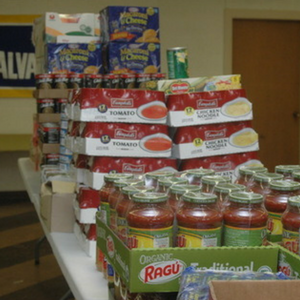 Children's art displayed in the West, Texas, long-term recovery organization offices. Children wrote their hopes and feelings to the city after a fertilizer plant explosion in 2013. ©Michelle Meyer, 2013.
Children's art displayed in the West, Texas, long-term recovery organization offices. Children wrote their hopes and feelings to the city after a fertilizer plant explosion in 2013. ©Michelle Meyer, 2013.
Two of the longest standing lessons of disaster are that neighbors help neighbors during disasters and that rebuilding from the devastation is a long process. How can donations and material resources be harnessed to support the most vulnerable populations long after the media focus has moved on? My National Science Foundation-funded research on long-term recovery committees provides important insights.

Donations collected by the University of Illinois Disaster Relief Volunteer Group after a tornado struck nearby areas. ©University of Illinois Springfield, 2007.
My colleagues from the Hazard Reduction and Recovery Center at Texas A&M University and I spoke with officials and nonprofit representatives who were leading long-term recovery teams in six communities across Texas. These communities had little in common except that they relied on nonprofit assistance and financial donations from the public to rebuild their homes and lives.
The Importance of Donations and Nonprofit Coordination to Long-term Recovery
Many assume that the Federal Emergency Management Agency (FEMA) or private insurance cover the costs of rebuilding houses. While this is true for some individuals, we expect that in flooding from Hurricane Harvey, a majority of individuals will be uninsured or underinsured. Homeowners will apply for FEMA aid, but it has a maximum benefit of around $35,000. The Small Business Association (SBA) provides another type of government support by issuing loans that must be repaid. Many people—especially low-income and elderly—will not qualify.
So what happens when insurance and government resources are not enough?
This is where financial donations to local nonprofits become important. Based on guidance from FEMA and the National Voluntary Organizations Active in Disaster (VOAD), community leaders will coordinate local, regional, and national nonprofits into a Long-Term Recovery Committee. These committees are designed to try to ensure that resources are not duplicated (and thus wasted) and that recovery funds go to those who need them most. Our research shows that these committees often take one of two forms:
- A new nonprofit specifically for long-term recovery, such as the Bastrop Long-Term Recovery Team.
- A network of nonprofits that collaborate to support long-term recovery.
Whether they chose the first or second option, these groups draw upon resources from numerous local and regional organizations to provide volunteer labor, in-kind donations, and financial support that can be channeled through a case management approach for unmet needs. To be successful with either process, building trust via transparency and openness is crucial.
Our work also demonstrates that long-term recovery leadership has to be trustworthy to garner the financial support of foundations and donors. How is trust built? Our research indicates that the following four components are key:
Diversity of long-term recovery committee membership. Include representatives from all nonprofits, city officials, faith-based groups, and representatives for the most vulnerable populations including elderly, low-income, homeless, and racial and ethnic minorities. Often the unmet needs in disaster are compounded by previous needs, especially for those living daily in poverty. Thus, the committee will need input from these groups to ensure that recovery information reaches those who most need it and that considerations are inclusive.
Local leadership. As the committee takes shape, external organizations will provide a wealth of advice about what to do and how to organize. Although these groups mean well, recovery is long and necessitates leadership that is local and will stay in the community during the rebuilding, which may take several years. Many disaster relief and recovery organizations travel from disaster to disaster taking experts and resources with them. In the past, some of local communities felt unprepared to take over recovery when disaster organizations left midway through rebuilding. As these organizations work to rebuild, we cannot emphasize enough the importance of donating money (more than things) to local nonprofits who will be rebuilding houses for one, two, or even up to 10 years or more.
Participation of experts. As long-term recovery continued to unfold, most of the committees we studied brought in experts including construction advisors, lawyers, title company advisors, bankers, accountants, case management specialists, and disaster recovery professionals. These experts played a vital role because recovery groups tackle issues across many spheres of survivors’ lives, and do so while under pressure to move resources quickly. These experts helped to ensure effective and efficient use of funds in each case management decision. Their early guidance—while recovery decisions are being made—adds accountability and helps the group avoid later mistakes that cost precious money and time.
Participation of survivors. Finally, many committees have trouble deciding how to incorporate the voices of survivors. Committees may think that not including survivors is supportive by not overburdening those who are recovering with committee work. Without the voices of the affected, however, efforts can become top-down and important needs that survivors value will be overlooked. The most successful committees have committee roles specifically for survivors to check and balance their mission.
The next several years will be trying for each of the Texas and Louisiana communities badly affected by Harvey. A knowledgeable and trusting coalition of nonprofits will harness the full generosity of the public to help individuals and entire communities rebuild in ways that are more just and resilient.
Michelle Meyer is the director of the Hazard Reduction and Recovery Center and an associate professor in the Landscape Architecture and Urban Planning Department at Texas A&M University. She received her PhD in sociology at Colorado State University. She uses the lens of social capital and collective efficacy to theoretically understand how relationships between individuals and between governmental and nongovernmental organizations generate or hinder disaster risk and recovery. Hence, her interests have led her to research expansively on volunteer organizations, volunteerism, and philanthropy in disaster.